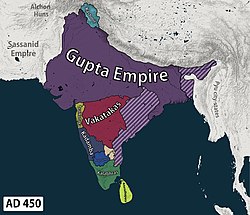Traikutaka dynasty
The Traikutakas were Abhira Kings who ruled Traikutaka kingdom from 388 to 456. Their name comes from the words for a three-peaked mountain ("Tri-kuta"). Kalidasa's Raghuvamsa mentions them, placing them in northern Konkan. The Traikutakas' territory extended to Aparanta and northern Maharashtra.[2] The Traikuṭakas who were a branch of the Abhira kings of the Puranas. They rose to power about 250 A. D. about the time of the middle Kshatrapas and after the decline of the Kshatrapas which began in 300 A. D. The disruption of their empire was probably the work of The Traikutakas who were their old neighbours and foes. Under the name of Haihayas the Traikuṭakas rose to supremacy about A. D. 455-6 established a branch at the city of Trikuta (most probably modern Junnar in the Poona district) and ruled over the Bombay Dakhan and South Gujarat during the period between 410 A.D.[3][4][5]
Traikutaka dynasty | |||||||||||
|---|---|---|---|---|---|---|---|---|---|---|---|
| c. 388 CE–c. 456 CE | |||||||||||
 Map of the territory of the Traikutakas (in yellow), along with their contemporaries, especially the Kadambas, the Vakatakas and the Gupta Empire. | |||||||||||
| Common languages | Sanskrit Prakrit | ||||||||||
| Religion | Hinduism | ||||||||||
| History | |||||||||||
• Established | c. 388 CE | ||||||||||
• Disestablished | c. 456 CE | ||||||||||
| |||||||||||
History
changeArchaeologist and scholar Bhagwan Lal Indraji considered the Traikutakas to be a branch of the Abhiras and connected them further with the later Haihayas.[6] some scholars identified the Traikutakas with the Kalachuris.[7][8] After the Satavahans, the Traikutakas or Kalachuris rose to power in A.D. 249 Certain coins go to prove that the Trikutakas who belonged to the Abhira caste came by sea from Sindh in about A.D. 249 under a leader called Isvaradatta. They made Trikuta on the western coast their capital and called themselves Traikutakas. Later when they were driven to Central India they began to be called Kalachuris and Haihayas. The Kshatrapas drove them away for a time but later under a king Dharasena they regained power in about A.D. 456.[9]
The region over which this dynasty held sway was identical with or formed part of the territory of the Western Kshatrapas. The dominion of the Traikutakas is also admitted to have extended over the same tract of territory on the West Coast. The Abhiras and Traikutakas really belonged to the same family, the dynasty ordinarily known as Traikutaka being only the descendants of the Abhiras. The word Abhira denotes only the hill-race or tribe to which the family belonged and the Abhiras are mentioned among the tribes that were subject to Samudragupta’s rule. The title Traikutaka of the dynasty is only regional and indicates that their territory lay round Trikuta on the Western Coastal region. It included probably a good part of the North Bombay Presidency, Gujarat and Kathiawar.
References
change- ↑ Rapson, E. J. (Edward James) (1908). Catalogue of the coins of the Andhra dynasty, the Western Ksatrapas, the Traikutaka dynasty, and the "Bodhi" dynasty. London : Printed by order of the Trustees. p. 198.
- ↑ Rapson p.clxxxv.
- ↑ Divatia, N. B. (1921). Gujarāti Language and Literature. Macmillan. p. 27.
- ↑ Singh, M. R. (1972). Geographical Data in the Early Purāṇas: A Critical Study. Punthi Pustak. p. 131.
- ↑ Chaudhuri, Sashi Bhusan (1955). Ethnic Settlements in Ancient India: Northern India. General Printers and Publishers. p. 46.
- ↑ Collins, Mark (1907). The Geographical Data of Raghuvamśa and Daśakumāracarita Considered More Especially in Their Bearing Upon the Date of These Works. G. Kreysing. p. 45.
- ↑ Madras, Andhra Historical Research Society, Rajahmundry (1940). Quarterly Journal of the Andhra Historical Research Society. Andhra Historical Research Society. p. 168.
{{cite book}}: CS1 maint: multiple names: authors list (link) - ↑ Verma, Rajiv Kumar (2002). Feudal Social Formation in Early Medieval India: A Study of Kalachuris of Tripuri. Anamika. p. 152. ISBN 978-81-7975-015-5.
- ↑ Solanki, A. N. (1976). The Dhodias: A Tribe of South Gujarat Area. Maria Enzersdorf : Elisabeth Stiglmayr. p. 27.
![Silver coin of king Dharasena. Obv: Bust of king. Rev: Chaitya and star. Brahmi inscription: "The glorious king Dahrasena, foremost follower of Vishnu, and son of king Indradatta".[1] of Traikutaka dynasty](http://upload.wikimedia.org/wikipedia/commons/thumb/3/3c/Dharasena%2C_Traikutaka_Dynasty.jpg/270px-Dharasena%2C_Traikutaka_Dynasty.jpg)